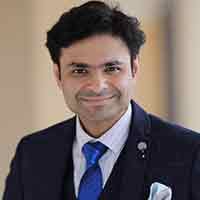What is Cataract?
A cataract is a clouding of the eye's natural lens, which is usually clear and allows light to pass through and concentrate on the retina. Cataracts can develop due to several factors, such as aging, injury, genetics, or certain medical conditions. As the lens becomes cloudy, it can cause blurred or hazy vision, increased sensitivity to glare, problems seeingat night, and overall diminished visual clarity.
Cataract surgery is a common and highly effective medical procedure to extract the clouded lens and replace it with an artificial intraocular lens (IOL). The surgery strives to improve vision and restore clear eyesight. Cataract surgery is one of the most common and successful surgical procedures performed worldwide. The surgery can significantly enhance vision and quality of life for people affected by cataracts. With advancements in surgical procedures and intraocular lens technology,the results of cataract treatment have become increasingly favorable, and the recovery period is usually relatively short.
What Are The Types Of Cataract Surgery?
There are different types of cataract surgery techniques. The main types of cataract surgery include the following:
- Phacoemulsification: Phacoemulsification is the most common and widely used method for cataract surgery. It involves employing an ultrasonic probe to break up the cloudy lens into small fragments, which are then gently suctioned out of the eye. This procedure usually needs a small incision (around 2-3 mm) and is generally performed under local anesthesia. Because the incision is small, it usually needs fewer stitches or none at all, and recovery is often quicker than other techniques.
- Extracapsular Cataract Extraction (ECCE): ECCE was more commonly used before phacoemulsification. In this procedure, a larger incision (around 10-12 mm) is created in the eye to remove the cloudy lens in one piece. While this technique is less commonly utilized today, it might still be considered in cases where phacoemulsification is not viable due to certainfactors, such as advanced cataracts or specific patient needs.
- Laser-Assisted Cataract Surgery (LACS): This method uses a femtosecond laser to perform some of the initial steps of the surgery, such as making the incisions and softening the cataract for easier removal. LACS can offer greater precision andpotentially decrease the use of ultrasound energy in phacoemulsification.
- Manual Small Incision Cataract Surgery (MSICS): Similar to ECCE, MSICS involves creating a larger incision. But, in thisprocedure, the surgeon extracts the central part of the lens while leaving the posterior capsule intact.
- Microincision Cataract Surgery (MICS): MICS is a type of cataract-removal surgery that uses a small incision, usually less than 1.8 mm. This minimally invasive procedure can be completed in 10 minutes or less. It is often used to treat patients with very small or dense cataracts. Many individuals who need cataract surgery can avoid traditional, open-incision surgery with MICS. This is because the tiny incision used for this technique means less trauma and scarring, which can leadto a shorter recovery time than traditional cataract removal.
The choice of cataract surgery technique depends on various factors, including the severity and characteristics of the cataract, the surgeon's experience and expertise, the patient's eye health, etc. Your ophthalmologist or eye surgeon willassess your specific case and suggest the most suitable technique for you.
Cost Of Various Types Of Cataract Surgery In Bangalore
| Types of Surgery | Minimum Cost (Rs.) | Average Cost (Rs.) | Maximum Cost (Rs.) |
| Phacoemulsification | 35,000 | 82,500 | 1,40,000 |
| Extracapsular Cataract Extraction (ECCE) | 35,000 | 82,500 | 1,40,000 |
| Laser-Assisted Cataract Surgery (LACS) | 50,000 | 90,000 | 1,40,000 |
| Manual Small Incision Cataract Surgery (MSICS) | 25,000 | 76,500 | 1,40,000 |
| Microincision Cataract Surgery (MICS) | 50,000 | 90,000 | 1,40,000 |
What is the cost of various types of cataract lenses in Bangalore?
Here's an approximate idea of cataract lens cost in Bangalore:
- Monofocal Lens: Monofocal lenses are the most basic type of cataract lens. These lenses are typically the least expensiveoption, with prices ranging from around Rs. 1,000 to Rs. 5,000 (approximately).
- Multifocal Lens: Multifocal lenses are designed to provide clear vision at multiple distances, reducing the need forglasses after cataract surgery. Prices can range from Rs. 20,000 to Rs. 50,000 (approximately).
- Toric Lens: Toric lenses are used to correct astigmatism along with cataract removal. The cost of toric lenses can rangefrom Rs. 15,000 to Re. 40,000 (approximately).
It's important to note that these price ranges are approximate and can vary based on factors like the brand of the lens,the specific technology used, the reputation of the clinic or hospital, etc.
What Factors Affect The Cost Of Cataract Surgery In Bangalore?
Several factors can impact the cost of cataract surgery in Bangalore. Some of the factors that can affect the cost of surgeryin Bangalore include the following:
- Type of Healthcare Facility: The preference between public hospitals and private clinics can affect the surgery cost in Bangalore. Private facilities might charge more due to potentially higher-quality amenities and personalizedcare.
- Surgeon's Experience: Surgeons with more experience and a good reputation may charge higher fees fortheir services.
- Technology and Equipment: Using advanced technology and modern equipment, such as laser-assistedtechniques, may lead to a higher cost of surgery.
- Type of Intraocular Lens (IOL): The type of IOL selected for the surgery can significantly influence thecost of cataract surgery in Bangalore. Premium multifocal or toric lenses are more costly than basic monofocal lenses.
- Pre-operative and Post-operative Care: Including preoperative consultations, post-operative visits,medications, and follow-up care can affect the overall cost of surgery.
- Additional Procedures: If you require any added procedures, such as correcting astigmatism or addressingother eye conditions, this can increase the total cost of surgery.
- Medical Insurance: If you have medical insurance, the extent of coverage and the types of procedurescovered can impact your out-of-pocket expenses.
- Additional Expenses: Depending on your healthcare facility, there might be additional charges for hospital fees, anesthesia, operating room time, and other miscellaneous expenses. These miscellaneous expenses can impact theoverall cataract treatment cost in Bangalore.
- Patient-Specific Factors: Your overall health, the severity of the cataract, and any specificrequirements you have might influence the cost.
Does Insurance Cover Cataract Surgery Costs In Bangalore?
Yes, you can get coverage for cataract surgery in Bangalore under your health insurance plan since it is considered a medically necessary procedure to enhance vision. However, insurance coverage for cataract surgery can differ depending on thetype of insurance plan you have, the specific terms of your policy, etc. Here are some points to consider:
- Health Insurance: In many cases, health insurance plans cover the cost of cataract surgery. However, the extent of coverage can vary. Some insurance plans might cover the basic procedure and a standard monofocal IOL, while others offercoverage for more advanced IOL options or premium lenses.
- Private Insurance Plans: Coverage can vary if you have private health insurance through your employer or purchasedindependently. Some plans cover cataract surgery and associated expenses, while others might have specific limitations.
- Deductibles and Copayments: Even if your insurance covers cataract surgery, you might still have to pay deductibles,co-payments, or co-insurance, depending on the terms and conditions of your insurance policy.















































